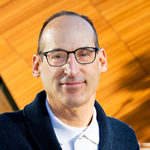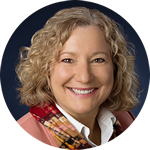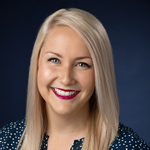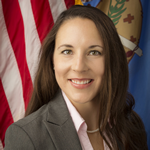
Rebekkah Smith Aldrich is the Executive Director, Mid-Hudson Library System (New York), a cooperative library system chartered by the New York Board of Regents. She's also one of the keynote speakers for the Exchange, and her address is titled "Sustainable Thinking for the Future of Libraries." That keynote will take place on Friday, May 8, 2020, at 12:10 p.m. EDT.
The following is a Q & A with Ms. Smith Aldrich.
1. How did you become involved with sustainability and libraries?
RSA: Much of my career has been focused on the need to inspire taxpayers, government officials and private donors to invest in libraries. Passing budget votes, referendum for capital projects, designing capital campaigns and smaller fundraising efforts puts a microscope on whether or not an institution is worthy of investment from members of our communities. Are we worthy? Working backwards from that question next led me to think about our values as a profession. We’re a noble profession doing good work that makes a difference in people’s lives. That should be enough, but often isn’t. We need to live our values out loud in everything we do. Our values must be infused in our polices, procedures, facilities, service and program design. If we truly care about those who work in our institutions and those we serve, that should be evident down to the bones of our work. That means we need to start at the beginning, every choice we make tells a story about who we are as professionals and as important community assets that have immense influence over those we serve. How we build buildings, what materials we choose to furnish our facilities with, where do our office products come from, where do they go when we are done with them are just as important as how we treat our staff and patrons, what books we put in our collection, and what programs we develop for our constituents.
Environmental sustainability should be evidenced in our work, alongside a commitment to social equity and fiscal stewardship. This is the “triple bottom line” by which we can create libraries that are focused on the right things, that produce working and learning environments that are healthy for people and a place from which to embed our service design philosophy so that we are focused on the right things – helping those we serve thrive in today’s world.
There’s no bigger shared interest than the health and well-being of our world. It impacts us all and library leaders should take responsibility for caring enough to prioritize the Earth if they truly want to live their professional values out loud.
2. You co-chaired ALA’s Special Task Force on Sustainability. The Task Force’s final report includes this quote, “When considering the urgent environmental threats – air and water quality, food insecurity, depletion of natural resources, rising sea levels, more frequent severe weather and the multitude of economic, political, technological and social disruptions that are evolving concurrently with these life-threatening developments, what the world needs now is more empathy, respect and understanding so that people can pull together to find shared solutions to the issues that affect us all.” Can you elaborate on this statement, which by the way, is so relevant to our current circumstances? What steps can library professionals take to help others thrive in the face of adversity and challenge?
RSA: In my opinion, the most critical element to deal with the climate crisis is social cohesion. The very nature of crisis and disruption is that it has unpredictable elements to it, otherwise we’d have a clear plan and know just what to do to minimize damage to our society. When you don’t have a clear plan, you need smart people who can come together to figure things out and both draw on existing assets of a community as well as source new assets – whether they be physical or intellectual – to solve a particular issue.
As we watch our world leaders tackle the COVID-19 crisis, we can see that the communities that came together to care for one another, to support those who were more vulnerable, to create face masks when a local hospital’s PPE supply was running low – these are the communities that will have less people who die from the virus. Communities that are in denial, who circle the wagons and hoard needed supplies and let the more vulnerable in our communities fend for themselves exacerbate the problem, increasing infection rates and depleting the support system that wasn’t designed for such a catastrophe. If we focus – long-term – on generating empathy, respect and understanding, we’ll bolster a community’s resilience in the face of what’s to come – whatever that may be.
To do this, we need to focus on both the social connectivity and the practical aspects of resilience. Social connectivity can be strengthened in so many ways through library programs and services – choosing titles for a community read that tell stories of compassion, empathy, and a broader understanding of those not like yourself; children’s programs that infuse good citizenship, kindness – as well as through a library’s policies – how we treat staff and patrons through our institutional choices. The practical aspects of resilience – access to food, shelter, clean water, and safety can be addressed through a library’s own facility design and planning – renewable energy sources, greywater systems, generators that enable the facility to serve as a refuge or cooling center; as well as through the programs and partnerships they seek out – programs on self-sufficiency like food production, preserving and canning; repair cafes and fix-it programs; partnerships with first responders for disaster preparedness thinking and training – a focus on local – how will we communicate locally should traditional means of communication break down, how will food supplies be addressed if supply lines are compromised, how will kids be educated if they cannot enter school facilities for a long period of time? Many of these things, which once seemed very farfetched, have come into sharp focus during the COVID-19 crisis; it has greatly tested our business continuity planning and revealed areas that need attention for the future.
3. When people see or hear the term “sustainable,” they tend think in solely in terms of the environment. What are some ways that people can be encouraged to think differently so that they may develop sustainable solutions for their facilities as well as funding and leadership?
RSA: The definition of sustainability has been one of the most important messages to convey throughout our work on this topic. To help people understand that nothing exists in a vacuum, it’s all connected, means we need to deploy a whole-systems thinking strategy to truly produce libraries and communities that are sustainable. This is represented by the “three-legged stool” or triple bottom line definition of sustainability:
• Environmentally Sound
• Socially Equitable
• Fiscal Stewardship
If one of these elements is missing in a decision, facility design, product or policy, it’s highly likely it’s not sustainable. It’s through the balance of these three things that we design sustainable paths forward in our world.
I think we can encourage people to think differently by helping them see how things are connected: how a choice in the business office about copy paper isn’t just about the bottom line of how much it costs, but also about from where that paper came, what resources it took to create it, and where it will go at the end of its useful life. Just thinking through that one product can be incredibly eye opening. Very cool things can emerge, such as realizing you can make a better choice for the environment and actually pay less for the same outcome; it could result in realizing that we use way too much paper and find ways to cut down on that. This same step-by-step thinking can be applied to much larger systems such as paying a living wage, supporting local businesses, building facilities that are human-centric. Basic eco-literacy can go a long way.
4. Please discuss sustainability leadership and what it means. How can sustainability leadership become part of change management?
RSA: Sustainability leadership is a holistic, long-term approach to understanding how to create institutions built to withstand what’s coming. Change is always happening, sometimes on a short or small scale, sometimes on a long or large scale, but usually in between. Sustainability leadership asks us to take a very long view, to keep our eye on a horizon point rather than a calendar and to adopt a mindset of continuous improvement using the triple bottom line as our guiding light. Rather than change management, I see sustainability leadership as framing change as evolution - as a living organism, our institutions are evolving to not only respond or react but to lead the future.
5. What are some immediate steps that library professionals can take to initiate change and bring about sustainability in their libraries?
RSA: Start talking, find others who feel like you do. Institute policy at the governance and administration level of the organization to embed sustainable thinking and convert it to practice. It’s a big lift and one that will take buy-in at every level. What I’ve seen be effective is a champion who can help make the case, teams that can then translate vision into action and then thoughtful leadership that can align their library with community partners who have similar vision. That’s when true collective impact that makes a large-scale difference starts to happen.
6. The Mid-Hudson Library System is enormous, with sixty-six member libraries. The system’s website has a section devoted to sustainable libraries. How is sustainability practiced/instituted among the system’s members?
RSA: Each of our member libraries’ is autonomous with a locally appointed or elected board – that board of trustees is critical to the sustainability of the library. Trustee education and support for our member library directors is a huge focus for us to help them devise policy, programs and services that translate to supporting the needs and aspirations of those they serve. Many of our conversations are kicked off by the pursuit of sustainable funding, meaning voter-designated revenue that’s not compromised by the whim of a new administration. Direct relationships with taxpayers/voters is a way for a community to decide what kind of community they want to be, one that invests in the education infrastructure like the library or one that de-invests in itself. Building credibility, trust, respect and good financial stewardship are the building blocks of helping our libraries be sustainable for the future so they can be co-creators of resilient communities.
7. How can libraries become involved in the Sustainable Library Certification Program?
RSA: The Sustainable Library Certification Program is currently working with fifty libraries in New York State and will be available nationally later this year. There’s no exam or worthiness test to start. We’re interested in working with libraries that have buy-in from the governance and administrative level who understand the importance of the work and want to approach it methodically to aid in a comprehensive look at a library’s policies and practices while positioning themselves as critical allies in their community, in their school or on their campus to address sustainable, resilient and regenerative approaches to the future. Visit https://sustainablelibrariesinitiative.org/ to learn more.
Visit the Exchange website for a full schedule and registration information.
 Steven J. Bell is the Associate University Librarian for Research and Instructional Services at Temple University. He’ll present the session “3 C’s for Leading Community Engagement Initiatives in Academic Libraries” on May 4, 3:25 p.m. EDT. His guest blog post follows.
Steven J. Bell is the Associate University Librarian for Research and Instructional Services at Temple University. He’ll present the session “3 C’s for Leading Community Engagement Initiatives in Academic Libraries” on May 4, 3:25 p.m. EDT. His guest blog post follows.


